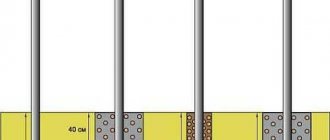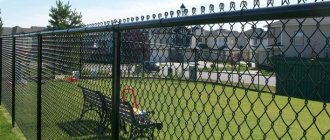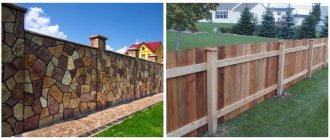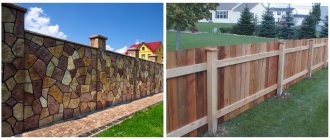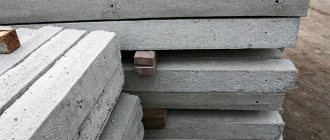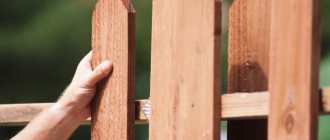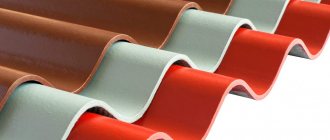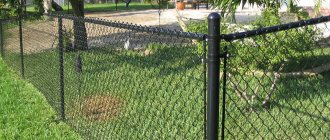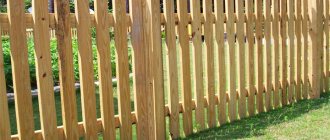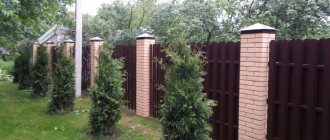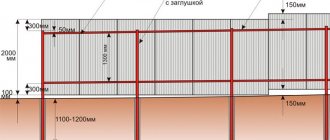Due to their cheapness and practicality, fences made of corrugated sheets are gaining popularity among the population. They are, of course, not a masterpiece of architecture, but they cope with their task perfectly.
The specificity of fences of this type lies in their low mass and at the same time large windage. Therefore, if the material for the support pillars is incorrectly selected or installed incorrectly, the structure may collapse, the corrugated sheets may be bent in an arc, or some other trouble may occur.
The article will discuss which fence posts are best to choose, the rules for their installation, the advantages and disadvantages of different types of posts will be discussed.
Types of support posts for a fence with photos
When installing fences made of corrugated sheets, the following types of supports are used:
- metal fence posts made from round or rectangular pipes;
- concrete or brick structures;
- wooden supports;
- asbestos-cement pipes.
In terms of price-quality ratio, it is best to choose a metal structure; wooden poles are installed only in conditions of austerity - they do not last long even after treatment with an antiseptic and paint.
If strong winds often blow in the area where you plan to install the fence, then a wise decision would be to make massive concrete or brick supports. Asbestos-cement pipes are not often used due to their low mechanical strength.
Choosing reliable fence posts
Metal posts are used to create most fences:
- with forged gratings, welded sections;
- from corrugated board, siding;
- from mesh;
- from Euro picket fence;
- from wooden boards.
They often become the inside of a stone or brick pillar.
There are several options for rolled metal products on sale.
Profile pipes
Manufactured from low carbon steel. There are round, square and rectangular sections.
Photo: future fence posts
They are actively used for fences for a number of reasons:
- In the version with a rectangular cross-section, it is easier to mount sections to their edges. For this, special brackets are used and no welding machine is needed.
- Great view from both sides.
- Affordable price.
- Stiffening ribs increase the stability of the fence under the influence of strong winds.
Available in lengths from 2.5 to 6 m. Wall thickness 2–4 mm.
Suitable for fencing of varying complexity.
Round pipes
The cheapest of pipes. Both new and used are sold. Length from 2.5 to 6 m. Diameter – 57–108 mm.
Such poles will have to be installed and secured to the sections by welding.
Photo. When choosing recyclable materials, you should pay attention to the amount of corrosion. If it’s just a red coating of rust, then everything is in order - such material will last for a long time. If there are pipes with significant damage to the metal - through corrosion, it is better to abandon them. Or cut off such pieces if the length allows.
The semicircular surface causes inconvenience when drilling holes and reduces the rigidity of the part.
To increase the stability of the fasteners, you can take metal or plastic clamps and use them to secure the post and sectional material. Stabilizing plates will simplify installation.
Screw piles
It is recommended to install on swampy soils with a high peat content, since other types of supports on such soil will begin to deform.
They cost more than profile and round ones. You can try to make them yourself by welding from a standard round pipe or a cut steel ring.
Photo: making screw piles
You will learn about other features of fence supports in this article: “Wood fence on metal posts.”
Channels, angles, rails, and I-beams are also used as pillars . They are sold inexpensively at metal collection points. In terms of strength and service life, they are not inferior to pipes, they are inferior only in appearance.
Metal supports
Depending on the width of the span and the height of the fence, the diameter of the steel pipes acting as a support is selected. Accordingly, their diameter should be larger, the wider the span or the higher the structure.
The following types of rolled metal can serve as support pillars:
- round steel pipes;
- profile rectangular or square pipe;
- metal corner;
- I-beams and channels.
The most preferred are pipes and angles with a metal thickness of at least 3 mm. The corners are not welded together provided that the metal thickness is at least 6 mm. The supports are dug into the ground based on their height.
A third of the height on the surface must be in the ground, for example, with a fence height of 1.5 meters, at least half a meter of height must be concreted into the ground.
Overall dimensions of pipes
We list the main dimensions of metal pipes used for the manufacture of fences:
- Pipe wall thickness. It can be in the range of 1-12 mm. In our case, it is necessary to ensure that the walls have a thickness of at least 2 mm. It is better to choose a thickness of 4-5 mm.
- Section diameter. This parameter directly affects the stability of the supports. The larger the cross-sectional diameter, the more securely the stand will stand in the ground. However, pillars that are too thick should not be used either. Firstly, their installation will be fraught with significant difficulties, and secondly, under their own weight, such supports may become distorted. The diameter of 100x100 mm is the maximum permissible for the manufacture of fencing. The optimal diameter for the main supports is considered to be 57 mm for a round section, 60x60 mm for a square, and 40x60 mm for rectangular supports.
Pipes with a diameter of 60x60 mm or thinner ones can be used as intermediate supports. For example, 50x50, 50x40, 40x40 mm.
Any pipe, whether it has a cross-section of 57 or 60x60 mm, must be covered with something on top or welded to prevent moisture from getting inside it.
- Length. The standard lengths of iron pieces are 1.5, 3 and 6 m. Of course, they can be cut into pieces of the length you need. If you purchased pipes, say, 1.5 m, and this length is too short, the products can easily be extended by welding. The final length of the pipe for the fence is selected to be 50-70 cm longer than the planned height of its installation. This is based on the fact that the iron support will go into the ground to such a depth. On sandy and loose soils, installing a pipe may require deeper burial, up to 1 m or even more.
To make the supports stand more stable in the soil, it is recommended that after installing the pipes in the holes, drive them into the ground, and only then concrete the holes. The wind will not be able to twist such a stand even with increased windage of the fence.
Brick pillars
This design, despite its high cost and labor intensity, looks very solid, durable and adds massiveness to the fence. The following types of bricks are used to build supports:
- ceramic hollow and solid;
- silicate;
- facing.
To give the support rigidity, a profile pipe of square or rectangular cross-section is placed inside it, concreted into the ground.
A square pipe would be more convenient. Cross sections and corrugated sheets are attached to it, the length of the pipe is selected according to the cut of the brick. The entire support structure is made on a columnar foundation, going deep to a level below the depth of soil freezing.
What distance to choose between fence posts, and how to drill for their installation
Considering the advantages and disadvantages of fence posts, as well as their cost, many people opt for metal posts. The most common and universal installation method is pouring concrete. A depression is dug or drilled in the ground (approximately 50-60 cm or more, with a soil freezing depth of more than 50 cm), into which a metal pipe is lowered and filled with concrete. However, on loose and heaving soils, such an installation leads to deformation of the fence, since the soil near the concrete is not reinforced in any way and begins to push out the post. To prevent a fence with metal posts from becoming warped, it is optimal to use screw posts for the fence.
Pipes with a welded threaded part are screwed into the soil to the freezing depth (or slightly deeper); when the pile is screwed in, the soil is compacted. Sometimes, for additional fastening, a concrete solution is used, which is poured into the hole. In terms of strength, the blades of the pile hold the fence firmly. When a pile with a diameter of 100 mm is deepened by 1500 mm (with a blade of 300 mm), the bearing capacity of the section can reach up to 5 tons. A fence on screw piles is installed many times faster than when using concrete. The design is stronger, more durable, and more stable.
The distance between piles directly depends on the material used as sections. The most budget option is chain-link mesh. In this case, the distance between the piles can reach 3 m; when using sections of corrugated board, the distance is reduced to 1.5-2 m.
Wooden pillars
To ensure the reliability of the structure, you will need a beam with a cross-section of at least 10x10 cm, or a rounded beam with a diameter of 12 cm or more. The supports are treated with fire protection and concreted into the ground.
The part located in the ground can be additionally treated with tar or bitumen mastic. Coniferous species - pine, spruce, or larch - are suitable as materials for pillars, since they are less susceptible to rotting.
The service life of the supports can be significantly extended by driving the lower part of them into pre-concrete steel pipes and protecting the wood from rotting.
The corrugated sheeting is attached to the supports using self-tapping screws. Thus, the structure looks solid from the outside.
Welding of metal structuresFeatures of cold rolled sheets - production technology, features, dimensions, properties and markings
Technical features of hot-rolled sheet - classification, manufacturing method, application options and processing features
Concrete pillars
Concrete pillars always look powerful. Accordingly, they can withstand a more massive and tall fence. The developer has little choice in purchasing such poles. Either buy it or do it yourself.
Nowadays many modifications of reinforced concrete fences and posts for them are made. You can buy them separately from fence slabs. But everyone agrees that once the posts are brought to the site, the fence becomes “golden”. Unless the factory for their production is somewhere nearby.
Therefore, developers prefer to cast the pillars themselves. They don't see anything complicated about it. And they claim that if a certain technology is followed, their supports are even stronger than factory ones. But, anyway, the choice is yours.
Asbestos-cement supports
An asbestos cement pipe is concreted into the ground according to the same rules as a metal one. For the reliability of the structure, after installation is completed, it is recommended to fill the cavity in the asbestos-cement pipe with concrete; this will be more than enough to make reliable fence posts from corrugated board.
It is recommended to anchor the part located in the ground - drill holes in the pipe and insert strips of reinforcement into them. Such a simple structure, after filling the hole with concrete, will work as an anchor.
The crossbars are attached to the post using a bolted connection. Holes for bolts are drilled in the pipe for these purposes. With a span width of less than 3 meters, a 40x40 mm profile can be used as the material for the crossbars. The corrugated sheet is attached to the profile using self-tapping screws.
How to properly install metal pipes for a fence
In order for the installation of pipes for the fence to be of high quality, it is necessary to comply with certain requirements for the installation of the fence. The following conditions must be taken into account:
- Distance between adjacent pillars. The average distance is taken to be 3 m. This length of sections will allow the fence to maintain its rigidity and the necessary pliability to wind loads. If the fence is made of heavy material such as slate or sheet metal, then the distance can be reduced to 2 m. Another option is to install intermediate posts that partially take on the weight of each section of the fence.
- Required number of pillars. Knowing the distance between the pillars, the required number of pipes can be easily calculated. To this quantity is added 2-3 posts necessary for installing the wicket and gate.
We have examined the main types and parameters of pipes used for the construction of fences. Which pipes are best to install is decided on site. Much depends on the range of products in your warehouse, the cost of products, your individual preferences and financial capabilities. Sometimes it’s better to overpay a little, but buy high-quality products coated with a protective layer. In this case, you will hardly have to doubt their durability and load-bearing capabilities.
Types of pipes for intake: profile or round, what to choose
Experts say that round products have minimal resistance and rigidity. But in terms of ease of installation, they are much inferior to profile models. Rectangular supports and purlins are easily cut and joined using welding equipment. The flat coating ensures tight and rigid installation of all parts of the fence.
But with identical diameter and weight, the round pipe is superior to the profile version in terms of permissible bending force. Therefore, when installing round fence pipes, you can save money by using less support weight. It is also more convenient to drive the product into the soil by screwing it in with a collar.
